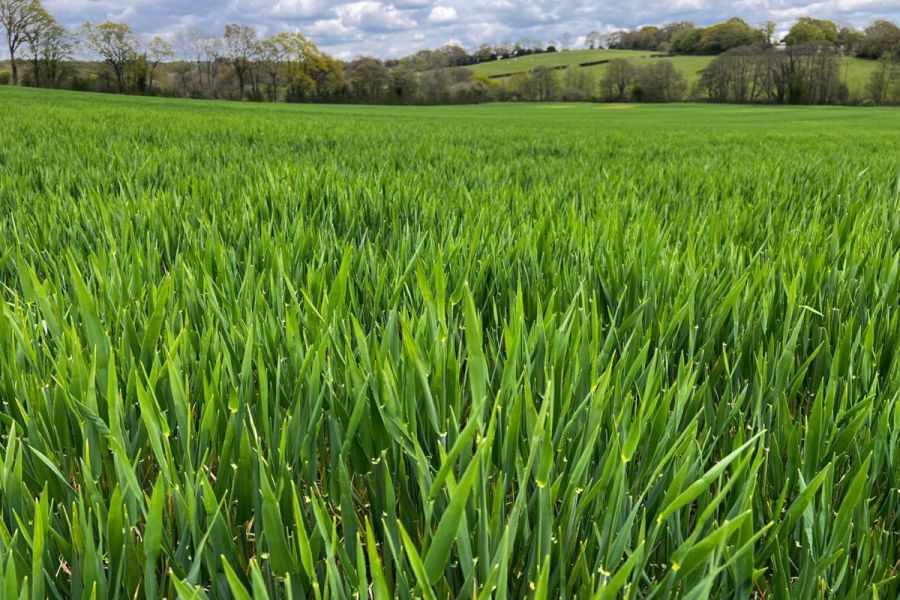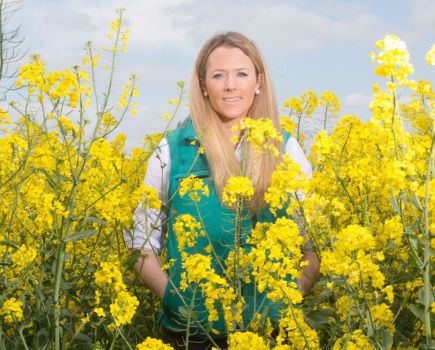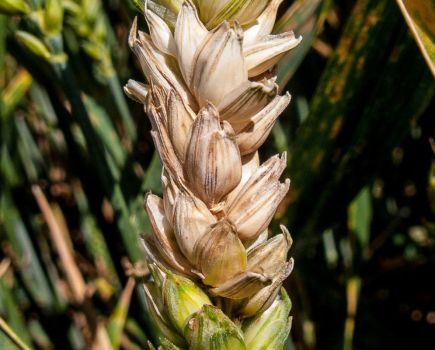Growing more comprehensive and steadfast disease tolerant and resistant varieties has become increasingly important in agriculture and with the launch of SY Buzzard, growers now have the option of BYDV tolerance in hybrid barley. CPM takes a closer look.
“There are lots of growers keen to stop using insecticides who feel genetics could be the solution.”
By Melanie Jenkins
In a first for barley breeding, SY Buzzard is a new six-row hybrid with tolerance to barley yellow dwarf virus (BYDV) which has been added to AHDB’s Recommended List for 2024/25.
Buzzard has the Yd2 gene, which is the same gene that’s in KWS Feeris, Amistar and Rafaela, says Syngenta’s Ben Urquhart. “But this is the first time it’s been present in a hybrid variety which is exciting for us. It means the variety has both BYDV tolerance and also all of the traits of a hybrid including grassweed suppression, a high and stable yield and hybrid vigour, both above and below ground.”
Ben feels that having BYDV tolerance in a hybrid barley brings significant benefits to growers. “Since the loss of Redigo Deter (prothioconazole+ clothianidin) we’ve seen increasing issues with BYDV. Although we haven’t had any terrible infection years recently – certainly nothing like what’s been seen on the Continent – it means that if we do, there can be a big impact on yield with losses of 30-40% in some cases. So to have some protection in-built into the variety is a useful attribute for farmers to have alongside their chemical toolbox.”
Syngenta has trialled Buzzard by inoculating it using BYDV-infected aphids to create an artificial high-pressure situation. “This was undertaken alongside a variety without BYDV tolerance,” says Ben. “The yield penalty was small compared with an uninfected plot of Buzzard and there was a far greater yield loss in the variety without tolerance. This demonstrates that Buzzard achieves good yields even where there’s some symptomology of infection.”
The trials also looked at spraying pyrethroids and found that there’s around 10 days more flexibility with the tolerance than without, because the development of the virus in Buzzard was slower, he adds.
Breeding BYDV tolerance into a hybrid variety was quite a hard task for Syngenta’s breeding team to undertake, explains the firm’s Joe Smith. “To create a hybrid variety we require a female and male parent but both parents have to be distinct with separate criteria. There also a sterile version of the female parent so when we introduce the male pollen, we can produce a fully fertile hybrid. What we want in the female is a shorter and earlier line whereas the male should be taller and later. If this is the wrong way around then it can be difficult to produce a hybrid,” he says.
“With Buzzard, both parents have BYDV tolerance meaning the Yd2 gene had to be introduced to both the female and male breeding pools. When you bring in any new trait to a breeding programme, there can often be unexpected penalties in other areas such as yield.
“So it’s been great to be able to select elite parents which when crossed to produce a hybrid, don’t have setbacks in other traits because of the BYDV tolerance. However, there were lots of breeding lines to dismiss from both parent pools before reaching this point.”
Now that Syngenta has introduced BYDV tolerance to its hybrid portfolio, Joe hopes to extend this to other varieties as well developing different virus tolerances and resistances. “Introducing a new novel trait into a gene pool is what takes the time but once it’s been established, we can really start to use different combinations to increase robustness. The next logical step is to back up tolerance with resistance by stacking or adding genes to the parents to create more robust disease packages. This’ll help to manage the potential loss of chemistry as well as tailoring varieties to sustainable agricultural practices,” he adds.
Agrii agronomist, Del Jenkins, first saw Buzzard in the company’s trials and as a result, recommended one of her growers plant the variety on his heavy Sussex land last autumn for its BYDV tolerance. “The farm is surrounded by woodland and hedges and so it’s the ideal situation for BYDV – something that’s been an issue before. The crop didn’t have an insecticide last autumn; as of mid-April there were no signs of BYDV and it’s the most even field of winter barley I’m currently working with.”
Aside from its notable BYDV tolerance, Buzzard is a high yielding variety at 103% of control, which has done well across all regions, says Ben. “It’s particularly suited to the East and is pretty competitive on both light and heavy soils.”
Compared with other hybrids, such as SY Kingsbarn, Buzzard’s yield potential is reduced, points out Del. “Although Buzzard yields less than Kingsbarn on paper, in heavy soil situations where growers can’t access land, this could actually be insignificant and Buzzard may well outyield it despite the five percentage point difference.”
Agronomically, the variety stands well with a preliminary score of 8 for its resistance to lodging without a PGR and scores a 7 with a PGR. “It seems to stand very well and was noticeably slightly shorter than other hybrids in trials but this isn’t to say it’s a short variety,” adds Ben.
“It’s advisable to still take a programmed approach to PGRs applying little and often to help spread the workload and to not have to rely on ethephon to do all of the late season heavy lifting,” he says. “When the ear comes out, the barley still has 50% of its growing to do, so little and often means you’re constantly checking the height and building a nice strong base for yield.”
Del feels that Buzzard’s resistance to lodging looks good but she does have general concerns about the straw length of all hybrids. “I take a belt and braces approach to PGR programmes and because I was worried about straw height, the crop of Buzzard I looked after had an early fungicide and PGR.”
In terms of disease, Buzzard scores a 7 for net blotch which is the highest score on the RL. “Having wet weather disease resistance, especially with what we’ve experienced this season, is of real benefit when you can’t go out and spray when you want to,” adds Ben.
The variety scores 6 across all of the other diseases on the RL. In Agrii’s 2023 trials, Buzzard did show a weakness for mildew and brown rust, but Del points out that neither of these diseases are a big problem in the area of the South East she manages. “I’m more focused on net blotch and rhynchosporium and Buzzard stood up well compared with the other varieties in Agrii’s trials.”
Looking at Buzzard’s growth habit, this is typical of a hybrid barley, says Ben. “We’d look to plant it at a lower seed rate to a conventional, at around 200-250 seeds/m² depending on the grassweed pressure and conditions at drilling. The crop will generally sit until the spring when the hybrid vigour becomes really noticeable; by February or March it just grows away especially when supported with an early application of nitrogen.”
Ben suggests using a standard hybrid barley nitrogen application split 30/50/20 with the first timing to support early growth and encourage the plant to hold onto its tillers to achieve yield.
Del believes most hybrids benefit from an early application of nitrogen. “I encouraged my Buzzard grower to apply early nitrogen as this can help with specific weight which might be especially useful for Buzzard.”
During the past three years, Syngenta has been conducting trials with ADAS looking at nitrogen use efficiency in hybrid barley. “This was a particularly hot topic when nitrogen prices went through the roof and what we’ve seen from the trials is that there’s potential to cut back nitrogen inputs modestly with minimal impact on yield. However, now prices have fallen, being able to cut back just offers flexibility rather than larger cost savings.
“Although Buzzard wasn’t one of the trial varieties, the four hybrid varieties we did look at were very consistent in their performance, whereas the conventionals reacted very differently to reduced nitrogen rates,” he adds.
Buzzard is the second earliest variety to mature of all the hybrids, coming in behind SY Kingston. “For growers looking to manage workloads on farm this provides a good option for an early harvest and entry into oilseed rape. Plus, thinking back to the past few harvests, having a crop in the barn and not out in the field where it might be rained on is definitely a bonus.”
Buzzard had its soft launch last year and Ben observed quite a lot of interest in it. “The variety fits in with the move towards sustainable and regenerative farming practices as there are lots of growers keen to stop using insecticides who feel genetics could be the solution.
“I’ve spoken to one grower who’s just planted Buzzard on his headlands in areas where he knows BYDV will be a risk, and another who’s mixed it with a second variety as a backstop in case he couldn’t spray when he planned to.”
The variety will be widely available to anyone looking to grow it this year, says Ben. “I initially thought Buzzard would be a largely South West variety grown in milder areas where BYDV could be a problem, but looking at where Buzzard was grown last year, it didn’t fit this pattern.
“So I think there are lots of different reasons why growers might choose it, whether it’s to drill earlier to avoid missing a weather window, or to reduce or completely cut insecticide use meaning cultural controls and genetics will be key. In addition, I think it’ll suit growers seeking more flexibility in their spray timings.”
This article was taken from the latest issue of CPM. Read the article in full here.
For more articles like this, subscribe here.
Sign up for Crop Production Magazine’s FREE e-newsletter here.




